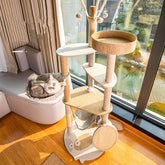Tongyeong's Cat School Under Fire: A Controversial Beginning in Animal Welfare
Table of Contents
- Key Highlights:
- Introduction
- A New Hope Turned Controversy
- Management Practices and Staffing Concerns
- City Response and Planned Improvements
- The Broader Context of Animal Welfare in South Korea
- Conclusion: A Path Forward for Animal Care
Key Highlights:
- Tongyeong's newly opened public cat protection and adoption center, known as the "Cat School," faces severe criticism over supposed neglect and inadequate care practices for its feline residents.
- Allegations include overcrowding, insufficient access to food and water, and lack of trained staff, leading to malnourishment and even death of vulnerable cats.
- The city of Tongyeong has responded to the concerns with plans for operational improvements and increased veterinary care, although many animal welfare advocates remain skeptical.
Introduction
The newly inaugurated Tongyeong Public Cat Protection and Adoption Center, popularly termed the "Cat School," opened its doors in September 2023, in an effort to safeguard and offer sanctuary to stray cats from the idyllic Hallyeohaesang National Park. However, what was once perceived as a hopeful initiative aimed at improving animal welfare has quickly been marred by controversy. Allegations of neglect and mismanagement have surfaced, raising questions about the efficacy of public facilities in ensuring the well-being of vulnerable animals. Activists and volunteers claim that conditions at the center have spiraled into a crisis, significantly endangering the lives of its furry inhabitants.
The plight of the cats at this facility highlights broader issues within animal welfare initiatives, particularly concerning the care provided under public management. With rising public concern and spirited criticism from activists, the future of the Cat School hangs in the balance, alongside the possability of reform measures being adopted to rectify current shortcomings.
A New Hope Turned Controversy
Established within a repurposed elementary school building in Yongcho Village, the Cat School was envisioned as a center of refuge, equipped with treatment rooms and dedicated spaces for feline inhabitants. It was celebrated at its opening as a progressive step toward addressing stray cat overpopulation and cruelty. Yet, shortly after its launch, statements from animal rights activists began to surface, revealing disturbing conditions inside the center that contradict this vision.
Critics contend that the facility, which reportedly houses 40 to 50 cats in a single room, lacks the necessary infrastructure for adequate separation among the animals. Such overcrowding has led to fierce territorial disputes and frequent physical altercations. More distressingly, the limited number of food and water bowls—along with inadequate litter boxes—means that weaker and younger cats are failing to thrive, leading to malnourishment and death.
The distressing case of a two-month-old kitten named Changdong, which activists claim died from neglect, has further fueled the uproar surrounding the center. According to those who volunteered regularly at the Cat School, Changdong was left without appropriate nourishment despite repeated requests to the staff for special care tailored to its needs. This heartbreaking incident has amplified calls for accountability regarding animal care standards within the facility.
Management Practices and Staffing Concerns
The situation at the Cat School has illuminated serious concerns over the management and operational practices being employed. A particularly glaring issue is the hiring of elderly staff members who, while certainly deserving of work opportunities, often lack experience with animal welfare. Critics assert that this workforce is inadequately equipped to assume the responsibilities that come with caring for a vulnerable and often traumatized group of animals.
This critique raises essential questions about the intersection of community support and expertise in animal care. While intentions to aid local residents may be admirable, such measures can inadvertently undermine the very mission aimed at protecting and caring for animals. A facility dedicated to feline welfare necessitates not only compassion but also knowledge and skill in handling unique animal needs, especially those of rescues that come from tough backgrounds.
City Response and Planned Improvements
Amid the mounting backlash, Tongyeong City has issued an official statement in response to the allegations. It has acknowledged the concerns raised regarding the conditions at the Cat School and affirmed its commitment to enhance operational standards. The city revealed that it allocates approximately 100 million won annually for meals and facility improvements, which reflects a significant investment in the center’s mission.
To bolster care for the cats, the city has promised to increase the frequency of veterinary visits from once to twice a month, working alongside the Korean Cat Veterinary Association. This partnership aims to ensure that proper medical care is administered and that health issues are promptly addressed.
Additionally, the recent "Cat Island Festival," organized in early August, indicates the city’s efforts to promote community awareness and sustainable practices regarding cohabitation with cats. The festival aimed to celebrate local culture while encouraging responsible pet ownership and advocacy for stray animals.
The Broader Context of Animal Welfare in South Korea
The controversies surrounding the Tongyeong "Cat School" are not isolated incidents but part of a broader narrative concerning animal welfare in South Korea. In recent years, the nation has seen a growing movement toward the protection of animals, influenced both by changing societal attitudes and increased advocacy by animal rights organizations. Nevertheless, incidents such as those at the Cat School call into question how effectively public institutions can transition to meet the evolving standards expected by the community.
Public facilities often face the dual challenge of advocating for animals while simultaneously fulfilling community needs. The tension between these priorities can lead to shortcomings in management practices, evident in the inadequate care observed at the Cat School. Fostering public engagement and establishing robust training programs for staff may be necessary steps toward ensuring the success of future animal welfare initiatives within public facilities.
Conclusion: A Path Forward for Animal Care
As the controversy surrounding the Cat School unfolds, it is evident that significant changes are required for the establishment to truly fulfill its mission of caring for the felines it was designed to protect. The responsibility lies not only with the city officials managing the shelter but also with the community that advocates for the welfare of stray animals.
Building a network of support that includes both volunteers and trained professionals is essential in creating an environment where animals can thrive and be safely sheltered. Evolving the landscape of animal welfare in South Korea requires an open dialogue among all stakeholders—government officials, animal rights activists, and local citizens—to create a collaborative framework that prioritizes the health and safety of all animals.
FAQ
What is the Tongyeong Public Cat Protection and Adoption Center?
The Tongyeong Public Cat Protection and Adoption Center, informally known as the "Cat School," is a facility opened in September 2023 aimed at caring for and facilitating the adoption of stray cats from the Hallyeohaesang National Park.
Why has the Cat School come under scrutiny?
The Cat School has faced criticism for alleged neglect and inadequate care practices, including overcrowded conditions, lack of proper food and water access, and insufficient trained staff.
What were the allegations involving the kitten named Changdong?
Changdong, a two-month-old kitten, reportedly died due to neglect at the center, with claims that it did not receive age-appropriate food or care despite repeated requests from volunteers.
What steps has the city of Tongyeong taken in response to concerns?
In response to the backlash, the city has pledged to improve operations by increasing veterinary visits and providing additional funding for meals and facility improvements.
How does the situation at the Cat School reflect broader issues in animal welfare in South Korea?
The issues highlighted at the Cat School illustrate ongoing challenges in public animal welfare practices in South Korea, raising questions about management effectiveness, staff training, and community engagement in animal care initiatives.





